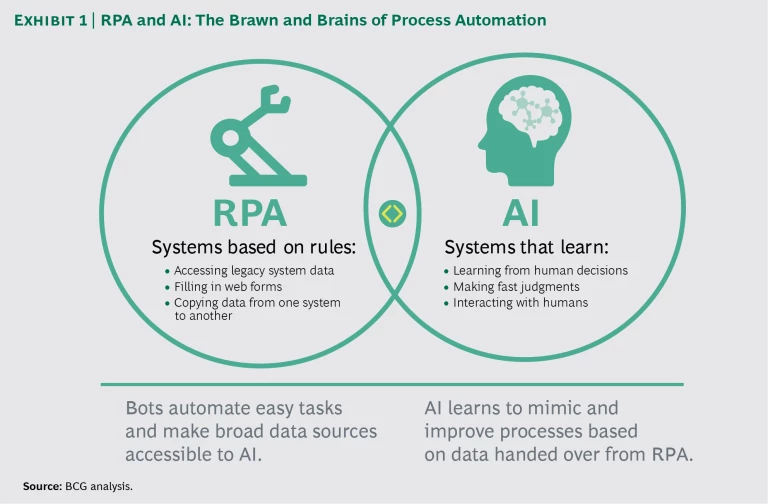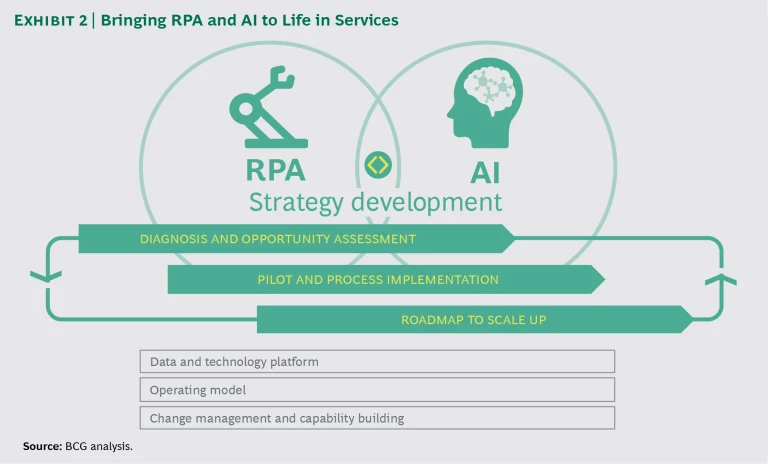Robotic process automation (RPA) and artificial intelligence (AI) have traditionally been viewed as separate and somewhat unequal worlds—RPA proponents consider AI to be impractical, while AI enthusiasts deem RPA primitive—but these two fields are highly complementary. Think of them as the brawn and the brains of performance. Companies can gain quick wins through RPA while strategically introducing AI for sustainable benefits and continual optimization.
Services are especially amenable to this approach. By services, we mean both service industries, such as banking, insurance, and telecommunications, as well as services provided by in-house support functions, such as finance, HR, and IT.
Similar to other technologies, however, RPA and AI are not cure-alls. But, by systematically incorporating both into their processes, service organizations can increase their productivity and boost their ability to generate insights. To succeed, companies should establish clear business objectives and define the role that RPA and AI will play in their overall optimization efforts.
In addition, companies should introduce these technologies through a clear change management program that addresses their impact on organizational and operational functions as well as on employees, who often feel threatened by robots and other labor-transforming methods.
Automation: Rise of the Robots
In recent years, RPA has gained popularity in service organizations. This tool allows software robots to replace computer activity traditionally performed by humans. These bots can open spreadsheets and databases, copy data between programs, compare entries, and perform other routine tasks. RPA is ideal for repetitive, rules-driven processes that span several IT systems—it’s like a macro on steroids.
These bots have several advantages over humans. They work 24-7, rarely make mistakes, accept new assignments, are easy to monitor, and operate four to five times faster than people. Generally, they pay for themselves within a year and help companies reduce costs by 20% to 80%, depending on the amount and complexity of the manual work they are replacing.
But for better or worse, RPA is a Band-Aid. It can be laid on top of existing IT systems without time-consuming and costly integration. However, it also can lead to a proliferation of similar spot fixes that threaten overall IT architecture and integrity.
So why is RPA a hot topic for many service organizations? First, vendors are offering powerful and intuitive drag-and-drop RPA software. And second, the application landscapes of organizations remain overly complex and still require too many manual steps. To simplify and accelerate their processes, many companies deploy hundreds or even thousands of bots.
For example, a telco started using them to automate what it called “revolving-chair processes,” activities that required humans to move back and forth among legacy back-office systems. These bots helped to verify contract terms and to manage service staff in the field. RPA paid for itself by a factor of two in the first year and by a factor of three or four in following years.
Despite these benefits, the telco’s introduction of bots also presented challenges that the company needed to address. IT systems required that the bots enter an employee number for verification. When worker councils expressed concerns about job losses, the telco reassigned affected employees and reduced outsourcing.
One broader drawback of RPA is that software bots are rule followers. They do not learn or improve. When rules conflict with reality or when unexpected events occur, a human needs to intervene. A leading furniture retailer introduced RPA to schedule deliveries, routing exceptions such as concurrent bookings to call center agents. For these exceptions, the bots provided the agents with full order histories and automated dialing, so the agents were fully prepared to speak with customers.
Although bots are faster than humans, they are still orders of magnitude slower than fully automated processes. For example, bots need to open and log in to applications; more deeply automated processes can handle tasks at the system level.
Given the limitations of RPA, companies frequently decide to explore even more ambitious solutions. That is where AI enters the picture.
AI: When Computers Can See, Speak, and Think
AI—the realization of intelligent behavior in computers—has reached new levels of performance and increasingly is embedded in business processes, interactions, and products. These machines process language and retain knowledge, so they can interact deeply and intuitively with people. Because they have also learned to “see,” they can leave the virtual world and join the real one. These capabilities have profound implications for future competitive advantage. More immediately, AI can improve at least three types of services:
- Tasks That Are Individually Easy but Collectively Cumbersome for Humans. Examples include classifying unstructured data, such as extracting information from an invoice, routing incoming emails, and reconciling names and addresses.
- Tasks That Humans Cannot Easily Perform. Examples include credit scoring, fraud detection, and high-speed algorithmic securities trading. Humans generally need rules to perform these tasks and the judgment to make exceptions. It’s an arduous set of processes that humans perform too slowly. Banks, for example, need to make quick decisions to stop potentially fraudulent transactions. By the time a human makes a decision, the transaction may have already been processed. Machines, on the other hand, can act in milliseconds and continually learn and improve by processing increasing volumes of information.
- Tasks That Require Human Interaction, Knowledge, or Both. Examples range from speaking to customers from a call center to offering legal advice, such as monitoring compliance, by following a set of rules or by first observing and then taking over the research, compliance, and simple advisory tasks of real lawyers.
The grouping of these tasks is imperfect because machines “think” differently than humans, and thus the line between the first two categories, where most activity is concentrated, is blurry. But it helps to lay the groundwork for how companies can use AI in services.
Many companies find AI challenging. Machines learn inductively by processing ever-greater volumes of data, and this learning does not happen on its own. Humans need to train the algorithms. With limited in-house AI capabilities, companies often turn to vendors, and these vendors sometimes oversell their AI capabilities, leading to disappointing AI pilot projects. (A forthcoming report to be published jointly by BCG and MIT will address AI training in greater detail.)
A large insurance company overcame this challenge by seeking vendor-agnostic advice about the most promising automation and AI projects. The insurer evaluated labor and claims costs, the ability to identify potentially fraudulent or inflated claims, and the strains that pursuing these claims might place on customer relationships. It identified operational and IT requirements, especially the fit between new and legacy systems, and examined a full range of solutions, from rules-based methods to advanced AI algorithms.
Ultimately, the insurer decided to build a team of internal AI experts to develop transparent algorithmic learning solutions for some areas rather than more advanced deep-learning approaches. For many other areas, the company concluded that traditional rules-based automation would work fine.
AI applications are not limited to financial services but apply across the entire industrial landscape. Retailers and consumer companies can microtarget offers to customers, B2B companies can cross-sell more effectively, and industrial goods companies can offer predictive maintenance services. A broad spectrum of companies can take advantage of AI for uses such as risk and compliance management as well as IT security.
Automation and Intelligence: Working Together
Many service organizations are starting to recognize the benefits of combining RPA and AI. They can achieve both the rapid payback of RPA and the advanced potential of AI. This combination is especially attractive for companies with large legacy systems—such as in the financial services and telecom industries or in HR and finance functions.
Employees can work together with both RPA and AI to optimize service processes. A natural transition from automation to intelligence occurs when a human intervenes in a rules-based process. For example, a bot routes text, digitized via optical-character recognition, to a human to classify items such as date, address, and topic. Over time, an AI system can take over this classification. As it improves, the system can gradually replace additional human interactions. (See Exhibit 1.)
An Asian bank took this approach to automation and intelligence in order to provide a better experience to customers, improve risk and compliance, and cut costs. The bank had already reduced head count by digitizing many discrete processes, but it wanted to go further.
To replace human tasks, the bank installed RPA and AI systems that learned on the fly. They routed cases to humans only when the systems were uncertain about what to do. Within four weeks, the AI system had achieved a 50% accuracy rate, and it eventually reached levels superior to those of humans.
By undergoing this automation and intelligence transformation, the bank reduced its costs by 20% and decreased from days to minutes the amount of time that it devoted to certain processes. In addition, the bank amassed a library of automation and AI modules that it can reuse in other contexts.
Fully automating all service processes does not make economic sense. But, even in more complex cases, organizations might be able to preprocess certain activities, reducing the human workload by 80% or more.
Getting Started
Your organization needs to introduce automation and intelligence in an organized and thoughtful way, in order to avoid falling victim to the seductive pitches of vendors and stumbling over common pitfalls. (See Exhibit 2.)
To Create Value, You Need a Strategy. Organizations need both a realistic perception of the risks and rewards of automation and intelligence as well as a clear understanding of the objectives they want to achieve. The overall RPA and AI strategy and target setting should help advance business priorities and reflect a clear understanding of the current maturity and the disruptive potential of emerging technologies.
To Move Forward, You Need Priorities. Companies need to objectively assess the current status of RPA and AI projects and identify a comprehensive set of opportunities. They should examine how they can leverage internal and external data sets and exploit the speed and scale of intelligent machines. To avoid myopia, this analysis should not happen in a vacuum but should be embedded in a wider range of efficiency and optimization efforts under way in the company.
One sensible approach to setting priorities is to create a heat map of RPA and AI opportunities across relevant products and processes, plotting value created against time to implementation. Organizations should identify the improvements with the highest potential payoff and realistically assess the current abilities of various technologies under consideration. They should also take an end-to-end view of implementation. One company, for example, rushed to automate a series of isolated tasks before realizing that this piecemeal approach would not reduce head count or achieve performance increases.
To Fly, You Need Pilots. When designing pilot projects, organizations should remember the saying “Practice does not make perfect. Perfect practice makes perfect.” By entering into pilots haphazardly, companies risk learning the wrong lessons. One company, for example, did not take an end-to-end view and installed robots in the middle of a value chain that created cumbersome issues at the front and back ends.
To Reach Your Destination, You Need a Roadmap. Companies should combine the insights they gained from setting priorities and running pilots and should create a comprehensive roadmap of their individual RPA and AI projects. Too often, we see experiments that lack transparency, coordination, and guidance—and unsurprisingly fall short of expectations. Companies need both a timetable and a plan that covers the underlying changes to technology, organization, people, and operations. A sponsor, preferably a C-suite executive, should oversee the transformation. As with all transformations, success starts at the top.
To Win, You Need to Integrate Data and Technology. Simple RPA systems are fairly easy to layer atop legacy systems. But the degree of difficulty rises with the sophistication and scale of the automation and intelligence that companies are introducing. Organizations must ensure that the new systems integrate seamlessly with call centers and other service centers, and they must establish a performance center to manage the overall automation and intelligence activities. And, as companies move into AI, they need access to large internal and external data sets. Vendors vary widely in their ability to support these integrations, however, so organizations need to critically assess vendor capabilities in this area.
To Leverage Automation and AI, You Need New Operating and Governance Models. Automation and intelligence change the nature and economics of work and consequently have significant implications for how companies should organize and deliver their services. Shared-service organizations will remain an important part of the mix, despite claims that automation reduces their relevance. Historically, many of these organizations have been located in low-wage markets to take advantage of labor cost arbitrage. In the future, the role of these organizations will become more strategic, shifting toward the delivery of digital capabilities, customer service, data analytics, and decision support.
More broadly, the rise of AI within organizations strains traditional organizational and process setups. As humans and machines interact in an environment of constant learning, functional and technical teams must collaborate more closely by working in agile ways. AI and agile are inherently iterative. In both, offerings and processes become continuous cycles. Algorithms learn from past outcomes, just as agile teams learn from rapid prototyping and fast feedback.
Ultimately, companies may be headed toward an “automation and intelligence first” imperative, similar to the “mobile first” mantra in multichannel environments. This push for ever-increasing performance and efficiency will free the workforce to devise the next wave of service improvements.
To Make Automation and AI Successful, You Need to Manage Change and Build Capabilities. Automation and intelligence are not just tools to be introduced in a vacuum. When implementing these new systems, an organization may encounter resistance from employees worried about their paycheck and from executives satisfied with the status quo. Both may discover that they need new skills to take advantage of changing opportunities.
Even if jobs are not in jeopardy, the introduction of robots and AI into an organization of people is challenging. Managers are generally not trained to oversee a mixed environment of robots and people. They may know how to communicate the changes to their staff but may not be prepared to address employees’ emotional concerns regarding automation.
One underestimated and unexpected challenge to implementation of these technology changes may come from the IT staff. These professionals may be comfortable with the new technologies but not with the collaboration required under agile ways of working. Or they may be uncomfortable with both.
In addition to managing employee reaction to the changes, organizations must also change their capabilities so they can meet two needs. The first, and obvious, need is to find a way to hire employees with modern technology skills at a time when competition for these people is high. To address talent scarcity, companies should consider managing their AI resources centrally, at least initially. The other, more subtle need is to retrain displaced employees for new roles and responsibilities. Augmented reality can help these employees transition from one job to another with minimal training on newer technologies.
Indian business process outsourcers have already faced these challenges in introducing automation and intelligence. The CEO of one of these companies told us that his organization removes several thousand employees a quarter from their traditional roles and gives them new tasks. His company has also trained more than 100,000 employees in design thinking, a method of devising new ideas that can be used to better serve customers.
The combination of RPA and AI is both a gift and a riddle. Companies can start benefiting from the gift today with fast-payback initiatives. The riddle they face is figuring out how to use RPA and AI to thrive in a more demanding environment tomorrow. As Lao Tzu said, “The journey of a thousand miles begins with one step.”














